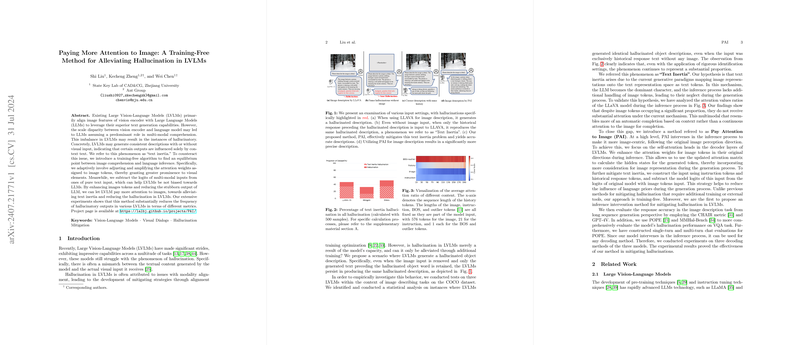Paying More Attention to Image: A Training-Free Method for Alleviating Hallucination in LVLMs
This paper addresses a persistent issue in Large Vision-LLMs (LVLMs): the generation of hallucinatory content due to an imbalance in attention allocation between visual and textual modalities. The authors propose a novel, training-free method named "Paying More Attention to Image" (PAI) to mitigate this problem by enhancing the attention weights assigned to image tokens during inference, thereby reducing the phenomenon termed as "text inertia."
The core observation driving this research is that existing LVLMs often generate consistent textual descriptions with or without visual input, indicating an excessive reliance on language priors. This phenomenon, described as text inertia, underscores the need to recalibrate the attention mechanism in favor of image tokens. The main contributions of the paper are summarized as follows:
- Identification of Text Inertia: The authors empirically verify that LVLMs can generate identical descriptions even when visual inputs are absent. By conditioning the model purely on historical text responses, they highlight the model's propensity to ignore visual cues, leading to hallucinatory content.
- PAI Methodology: The PAI method enhances the self-attention matrix during forward passes by magnifying the attention weights for image tokens. This intervention ensures that more attention is directed towards relevant visual features, thereby aligning the generated text with actual visual input. The method is designed to be training-free and compatible with various decoding strategies.
Specifically, PAI involves two main adjustments: - Attention Re-calibration: The attention weights for image tokens are adaptively enhanced using a hyper-parameter . This amplification is applied post model's original attention computation to preserve contextual coherence. - Input Logit Refinement: To further mitigate text inertia, the logits from multi-modal inputs are adjusted by subtracting the logits of pure textual inputs. This ensures that the final output distribution is more aligned with visual context rather than being overly influenced by language priors.
- Extensive Experimental Validation: Experiments are conducted on multiple benchmarks including the COCO dataset and utilize metrics such as CHAIR and POPE to evaluate the model's performance in reducing hallucinations. The evaluation framework also incorporates GPT-4V for more nuanced assessment.
Key Results:
- The PAI method significantly reduces the instance and sentence-level hallucinations across diverse LVLM architectures, with relative improvements observed in metrics evaluated over long sequence and VQA tasks.
- Comparison with baseline methods like OPERA and VCD demonstrated PAI's superior efficacy in enhancing attention to image features without additional computational overhead.
- The results suggest that even modest re-calibration of attention weights can mitigate hallucination effectively, particularly when is finely tuned.
Implications and Future Developments:
The findings underscore the importance of balanced attention mechanisms in multi-modal models. By addressing the inherent bias towards textual inputs, PAI not only reduces hallucinations but also enhances the interpretability and reliability of LVLM outputs.
Theoretical Impact:
This method highlights the potential of inference-time interventions in addressing alignment issues between vision and language modalities. It also opens avenues for further research into adaptive attention mechanisms that can dynamically re-calibrate based on the complexity and type of task.
Practical Impact:
For practitioners, PAI provides an efficient, training-free tool for improving the performance of LVLMs in real-world applications, ranging from automated image captioning to visual dialog systems. This approach can be seamlessly integrated into existing pipelines, offering immediate gains in output quality without the need for extensive re-training.
Future Speculations:
Looking forward, the application of similar inference-time interventions could be extended to other types of multi-modal models, such as those involving audio and text. Furthermore, future work might explore automated tuning of the amplification parameter and expand the framework to consider even more nuanced aspects of multi-modal interaction.
In conclusion, the paper presents a compelling, innovative approach to mitigating hallucination in LVLMs, emphasizing the critical role of balanced attention mechanisms. By demonstrating significant empirical improvements while being computationally efficient, PAI sets a new standard for enhancing the reliability of vision-language integrations.
